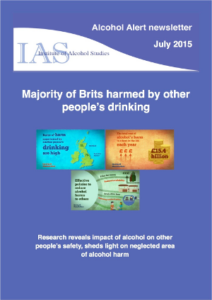In this month’s alert
Editorial – July 2015
Welcome to the July edition of Alcohol Alert, the Institute of Alcohol Studies newsletter, covering the latest updates on UK alcohol policy matters.
In this issue, a new IAS report finds that the majority of Brits are harmed by other people’s drinking, shedding light on a neglected area of alcohol harm. Other articles include: International study results show that up to 80% of expectant mothers admit to drinking alcohol while pregnant; The Advertising Standards Authority bans prominent Smirnoff advert from TV; and the Welsh Government begins its consultation looking into introducing a 50 pence minimum unit price for alcohol.
Please click on the article titles to read them. We hope you enjoy this edition.
Majority of Brits harmed by other people’s drinking
More than half of Scots and three-quarters of people from North West England are harmed by another person’s drinking, according to a new report
Produced by the Institute of Alcohol Studies with the University of Sheffield School of Health and Related Research (ScHARR), Alcohol’s Harm to Others examines the extent to which consuming alcohol can impact on people other than the drinker.
The report combines a review of the evidence on alcohol’s harm to others and data from two surveys in which over 2,000 adults* were asked about the harms experienced from others’ alcohol consumption. Two questionnaires were analysed for this report; one funded and carried out by Our Life and DrinkWise which surveyed 1,020 respondents aged 18 years and older living in the North West of England and the other funded by Alcohol Focus Scotland which surveyed 1,007 respondents aged 16 years and older living in Scotland.
Harms reported include being harassed or insulted on the street by someone who has been drinking, feeling unsafe in public, being kept awake at night and being sexually harassed.
The main findings of the report show that:
- 51.4% of people in Scotland and 78.7% of people in North West England had experienced harm from another person’s drinking. Most of these people reported multiple types of harm
- There is a link between age and rates of harm, with younger age groups (16-24 and 25-34 year-olds) reporting greater rates of harm than older age groups
- One in five adults have been harassed or insulted on the street by someone who has been drinking (20% Scotland; 23% North West England)
- 19% of people in Scotland and 36% of people in North West England had felt unsafe or threatened in public
- 30% of people in Scotland and almost half of those in North West England (49%) reported being kept awake at night because of drunken noise
- 15% of people in North West England report that someone who had been drinking gave them unwanted sexual attention or behaved in a sexually inappropriate way towards them.
The report also reviews prior evidence on and includes government figures that estimate alcohol’s harm to others costs the UK economy more than £15bn each year. The report concludes that more must be done to raise awareness and address harm to others. Evidence suggests a range of policies that could help to reduce alcohol’s harm to others, including:
- Offering screening and brief advice to drinkers who are most at risk of causing harm to themselves and others
- Better regulating the density of alcohol outlets and restricting their trading times
- Raising the price of the cheapest alcohol (through taxation and minimum unit pricing
- Lowering the legal drink-drive limit and introducing random roadside breath testing
Lead author Dr Lucy Gell from the School of Health and Related Research at the University of Sheffield said:
“Our findings indicate that a large number of people in Scotland and North West England experience harm from other people’s drinking, and in many cases multiple harms. This is especially true of younger adults who were far more likely to report having experienced harm in the past 12 months compared with older people.
“We need to better record alcohol’s harm to others across the health and social services and provide support services for those experiencing harm from other people’s drinking.
“Our team are now working to provide evidence to national and local governments about which mix of policies could best help to reduce the social harms associated with alcohol use.”
Katherine Brown, Director of IAS said:
“This report is important because it shows that the harms caused by alcohol extend far beyond individual drinkers, often affecting many people through no choice of their own.
“Alcohol harm is everybody’s business – as taxpayers we are all paying the price. We hope this government will look to the evidence of what works and take action, both to ease the heavy financial burden on our health, social care and police services, and to make our communities safer.”
Responding to the report, Dr Peter Carter, Chief Executive & General Secretary of the RCN said:
“The evidence in this report of the shattered lives and personal tragedies that can happen as a result of alcohol abuse is heartbreaking. It is high time that the UK recognised that it has an unhealthy drinking culture, and pulled together to reduce the harm done by alcohol.
“Alcohol and the other huge public health challenges facing our country will only be met through open debate and determined action. That means making expert advice and support available to prevent problem drinking, and helping those who have developed a problem.
“It is imperative that we tackle a dangerous culture where binge drinking is seen as a normal part of daily life in the UK.”
The report Alcohol’s Harm to Others was published by the Institute of Alcohol Studies in partnership with the School of Health and Related Research at the University of Sheffield.
Watch the animation video, which accompanies the report on our Vimeo channel, below:
IAS – Alcohol’s Harm to Others from The Institute of Alcohol Studies on Vimeo.
International study finds drinking during pregnancy “highly prevalent”
Women across all social groups drank during pregnancy, with smokers significantly more likely to do so
Drinking alcohol while pregnant is common, with up to 80% of expectant mothers admitting to having done so, according to an international study published in the online journal BMJ Open.
The researchers based their findings on an analysis of data from three studies: The Growing up in Ireland (GUI) study; the Screening for Pregnancy Endpoints (SCOPE) study; and the Pregnancy Risk Assessment Monitoring System (PRAMS) Ireland.
The studies variously assessed the amount and type of alcohol drunk before and during pregnancy of 17,244 women who delivered live babies in the UK, Ireland, Australia and New Zealand. The researchers used the results to gauge the prevalence of, and the factors associated with, drinking alcohol during pregnancy. GUI and PRAMS measured gestational alcohol use retrospectively, while SCOPE obtained measures of alcohol use during pregnancy. The findings were standardised across each cohort to ensure categories in each study were comparable, although alcohol use before pregnancy was not available in GUI.
The researchers’ analysis indicated high rates of drinking, including binge drinking, among pregnant women. They wrote: “Our findings show a high prevalence of alcohol use during pregnancy (ranging from 20% to 80% in Ireland, from 40% upwards in the UK, Australia and New Zealand), and high levels of binge drinking during pregnancy.”
The SCOPE study reported the highest overall prevalence of alcohol both pre-pregnancy (90% vs 77% in PRAMS) and during pregnancy (82% vs 46% PRAMS). SCOPE participants also reported the highest overall consumption levels both pre- and during pregnancy, and the highest binge consumption before (59%) and during pregnancy (45%).
Estimates of alcohol prevalence in the face-to-face GUI survey were significantly lower than in PRAMS (e.g. GUI reported the lowest overall consumption of alcohol use during pregnancy at 20%). The researchers suggest this finding supports the superiority of self-administered questionnaires (i.e. PRAMS) in measuring issues such as alcohol use.
The findings also indicated that the prevalence of drinking while pregnant was generally evident across all social strata, but several factors were associated with a heightened or lowered risk of alcohol consumption.
For instance, compared with white women, those of other ethnicities were less likely to drink alcohol while pregnant, while younger women (30-39) were also less likely to do so than older women. A higher level of education, having other children, and being overweight/obese were also associated with a lower risk of drinking while pregnant.
But the strongest and most consistent predictor of a heightened risk of drinking alcohol during pregnancy across all three studies was smoking; smokers were 17-50% more likely to drink while pregnant.
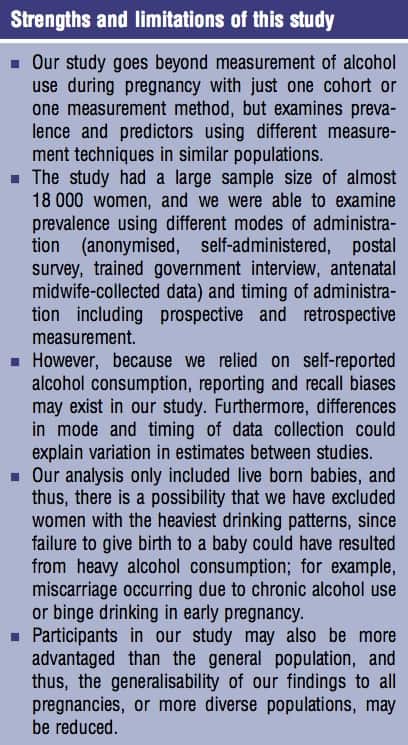 What the report didn’t (quite) say
What the report didn’t (quite) say
“A third of British women risk doing severe harm to their unborn babies by binge drinking during pregnancy,” was the Mail Online’s headline assessment of the scientific paper. But, as NHS Choices’s factcheck of the article observed, the evidence behind this title “is perhaps not as clear-cut as the Mail would lead its readers to believe”.
This is because while true that 75% of UK women involved in the SCOPE study reported drinking and 33% reported binge drinking at some point in pregnancy, this was from a total of 651 women – roughly 4% of total intake across all three studies – over several years (2004-2011) during which drinking habits may have changed considerably. Also, all UK data derived from three cities – London, Leeds, and Manchester.
The NHS Choices article concludes that this is “probably too small a sample size to confidently extrapolate it to current drinking habits among all pregnant women in the UK, as most headline writers have done.
Conclusion: Controversial advice?
The researchers write: “Alcohol use during pregnancy is highly prevalent, and evidence from this cross-cohort and cross-country comparison shows that gestational alcohol exposure may occur in over 75% of pregnancies in the UK and Ireland.”
However, most of these women consumed alcohol at very low levels and the number of pregnant women who drank heavily in the three studies was small, they say. Nevertheless, given that the risks of light drinking are not fully known, the most sensible option is not to drink alcohol during pregnancy, in line with clinical and government guidelines.
“Since most women who consume alcohol do so at lower levels where the offspring growth and development effects are less well understood [than at higher levels], the widespread consumption of even low levels of alcohol during pregnancy is a significant public health concern,” they conclude.
These comments were echoed by Louise Silverton, Director for midwifery at the Royal College of Midwives (RCM).
“The overall number of pregnant women who continue to drink alcohol during pregnancy is very concerning, as there is no evidence that any level of consumption is safe for the growing baby. This is why the RCM continues to advise women to abstain from drinking alcohol when pregnant or if trying to conceive. Drinking around conception and during the first three months may also increase the chance of having a miscarriage”, she said.
The researchers also remarked that the comparison study “highlights the urgent need for a biological marker of gestational alcohol use, since it is difficult to estimate to what extent estimates and their predictors are plausible even in more robust study designs and when data is analysed in a comparative design”.
This view raised concerns regarding the autonomy of women’s bodies during pregnancy. Clare Murphy, Director of External Affairs at the British Pregnancy Advisory Service said: “It is concerning that the authors of this paper are calling for biological tests so that pregnant women’s alcohol intake can be measured. The implication is that women’s own reports of their alcohol use cannot be trusted. We would be extremely wary of any measures which sought to further police pregnant women’s behaviour, and undermined the important relationship between a pregnant woman and her healthcare provider.”
Sharp rise in average consumption among underage drinkers
HSCIC release finds there are fewer underage drinkers, but those who did drink consumed more alcohol in the last week compared with previous year
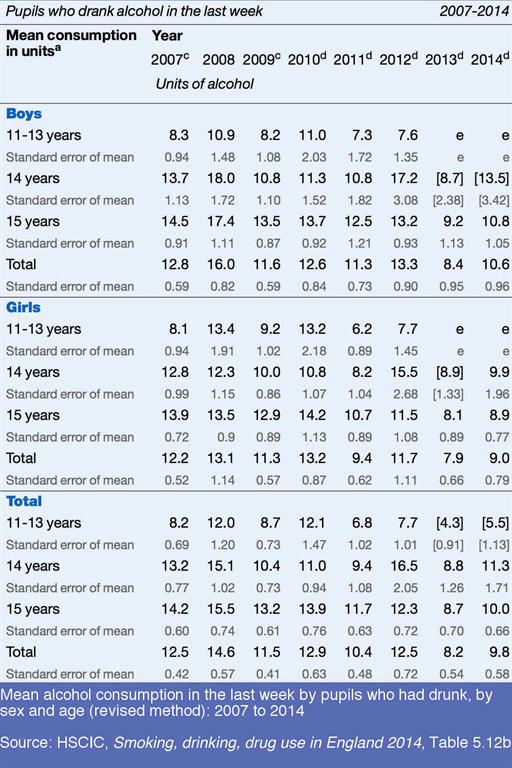 Mean average alcohol consumption in the last week among underage drinkers is up on the previous year, according to the new Smoking, drinking and drug use among young people in England release from the Health & Social Care Information Centre.
Mean average alcohol consumption in the last week among underage drinkers is up on the previous year, according to the new Smoking, drinking and drug use among young people in England release from the Health & Social Care Information Centre.
The amount consumed in the last week (illustrated) increased from 8.2 units in 2013 to 9.8 in 2014.
This rise occurred despite the continuing decline in the proportion of pupils drinking alcohol over the same period, from just over to just under a fifth (22% to 18%). It was 45% in 2004.
The downward trend in the proportion of pupils who had ever consumed alcohol also continued. In 2014, 38% of 11 to 15 year-olds had tried alcohol at least once, the lowest proportion since the survey began, and down 21 percentage points on a decade ago (59%).
The figures also showed that a majority (63%) of pupils who drank did so on one day of the week only, and that drinkers were most likely to do so on weekends. Despite the average (mean) consumption by pupils who drank in the last week was 9.8 units, 22% of them consumed at least 15 units.
The implication of these findings is that it is likely that a significant percentage of underage drinkers’ consumption patterns centre around a single binge drinking session on either a Saturday or a Sunday.
An evidence review of the scientific literature around the impact of alcohol on the adolescent brain by Scottish Health Action on Alcohol Problems (SHAAP) has shown that because of a different and largely greater sensitivity to alcohol than the adult brain, adolescents who drink are prone to neurological changes during the course of the brain’s development that may have long-lasting and possibly permanent effects.
Commenting on the results, Tom Smith, Head of Policy at Alcohol Concern, said: “It’s encouraging to see the downward drift in the number of young people who have ever drunk, but those that drink are drinking more than last year. Looking at the broader picture it’s a case of more alcohol down fewer throats.
“Alcohol continues to be the leading risk factor for deaths among men and women aged between 15 and 49 years in the UK. Young people in the UK continue to drink more than young people in most other developed countries and in 2013/14 and a staggering 10,000 children and young people accessed treatment last year citing alcohol as a reason.
“Factors for the recent decline in the number of young people drinking are likely to be due to younger generations becoming increasingly ethnically diverse, with higher proportions of non-drinking or low drinking backgrounds or cultures. We’ve also been through an economic downturn, where young people have been hit hard financially. As the economy picks up, we need to be vigilant that harmful alcohol consumption does not. The growth of the internet and social media may also be changing how young people communicate and spend their time.
“Young people themselves believe that an increase in the cost of alcohol and greater limitations on its availability are likely to be main drivers for change for their generation.”
Smoking, Drinking and Drug Use Among Young People in England 2014 surveyed 6,173 pupils in 210 schools in the autumn term of 2014.
Taskforce calls for national strategy to tackle alcohol consumption
Report stresses importance of tackling alcohol consumption as a major lifestyle factor influencing cancer outcomes
An estimated 4 in 10 cancer cases could be prevented largely through modifying aspects of our lifestyles, including alcohol, which is a major risk factor for cancer.
This verdict was one of several findings drawn from the report ‘Achieving world-class cancer outcomes: a strategy for England 2015-2020’, produced by the Independent Cancer Taskforce. The report set out recommendations for how to transform cancer services in England.
 Alcohol is one the main risk factors behind cancer. Others include tobacco, weight, diet, UV exposure and lack of sufficient physical activity. In its chapter on alcohol, the report’s authors wrote: “Excessive alcohol consumption leads to around 12,800 UK cases of cancer each year and is linked to several different types of cancer. As little as one standard drink a day can increase the risk of a number of cancers.
Alcohol is one the main risk factors behind cancer. Others include tobacco, weight, diet, UV exposure and lack of sufficient physical activity. In its chapter on alcohol, the report’s authors wrote: “Excessive alcohol consumption leads to around 12,800 UK cases of cancer each year and is linked to several different types of cancer. As little as one standard drink a day can increase the risk of a number of cancers.
“Awareness amongst the public of the links between alcohol and cancer specifically is low, with only a third identifying it as a risk factor.”
The authors then went on to say that Public Health England (PHE) has undertaken a rapid evidence review of alcohol harm and prevention and is writing a report to Government which will outline possible policy solutions, recommending that the PHE’s review “should form the basis for the development of a national strategy to address alcohol consumption, possibly including measures to tackle price, marketing, availability, information on products and social marketing campaigns to raise awareness.”
The solutions for dealing with alcohol misuse were part of an overall framework for delivering better quality cancer patient care in England. The Chair of the Taskforce, Cancer Research UK CEO Harpal Kumar (pictured), set out the opportunities to transform cancer services in a letter to the Chief Executives of the bodies responsible for running the NHS, and on the Cancer Research UK blog.
He wrote: “The NHS, working with local and national Government and the public, needs to take a much more proactive approach to public health, with a view to reducing the growth in the number of cases of cancer in the future. There are opportunities to address the range of lifestyle risk factors and also to boost efforts in prevention of secondary cancer.”
Six strategic priorities were listed as part of the report’s plans to deliver better prevention, swifter diagnosis and improved treatment and care for all cancer patients:
- Spearhead a radical upgrade in prevention and public health
- Drive a national ambition to achieve earlier diagnosis
- Establish patient experience as being on a par with clinical effectiveness and safety
- Transform our approach to support people living with and beyond cancer
- Make the necessary investments to deliver a modern high-quality service
- Overhaul processes for commissioning, accountability and provision
The document builds on the statement of intent published earlier this year, which assessed the opportunity for improved cancer care, set out the key questions for the Taskforce to address and outlined the key ambitions and initiatives to be considered.
Evelyn Gillan: Tribute to fearless alcohol policy campaigner
A host of figures from all walks of life have paid their respects to the Alcohol Focus Scotland chief executive, who passed away after a short illness
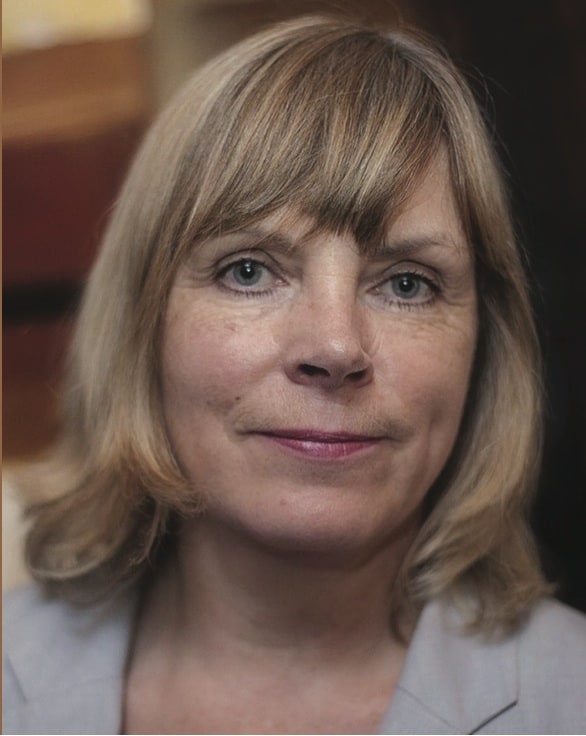 Tributes have been paid to Dr Evelyn Gillan who passed away on 14th July 2015. Evelyn was a revered social campaigner who played a key role in the passing of minimum unit pricing legislation in Scotland.
Tributes have been paid to Dr Evelyn Gillan who passed away on 14th July 2015. Evelyn was a revered social campaigner who played a key role in the passing of minimum unit pricing legislation in Scotland.
A statement from Alcohol Focus Scotland said staff were deeply saddened to announce her death – calling her leadership “inspirational” and saying she was “one in a million”. Acting Chief Executive Barbara O’Donnell said:
“Evelyn was an inspirational woman and public health advocate who was hugely respected both here in Scotland and by colleagues internationally. Her enthusiasm, leadership, energy and passion to change the world for the better were evident to all who had the privilege to know and work with her. Her sense of humour and her tenacity were legendary. She was one in a million and will be deeply missed by us all.”
An obituary published in the Scotsman documents Evelyn’s career path, which included co-founding the Edinburgh-based Zero Tolerance campaign*, designed to move the issue of violence against women and children further up the public and political agenda.
Zero Tolerance Board member Lesley Orr said: “Evelyn is in the great tradition of thrawn Scots who shake up complacency, disrupt the way things are, and won’t let go until they’ve been transformed. She spoke truth to power with integrity and humour. In a recent interview she was asked about the last thing that scared her. Evelyn’s response was: “I prefer hope over fear.”
Scotland’s First Minister Nicola Sturgeon also paid tribute to Evelyn. She said: “For me, the single word that best describes Evelyn is ‘passion’. She brought passion and enthusiasm to every cause she cared about – and, even more importantly, she possessed that all too rare ability to inspire other people to feel passionately about these causes too.
All staff at IAS were deeply saddened to learn of Evelyn’s passing. IAS Director Katherine Brown said:
“Evelyn was a remarkable woman and highly respected by all who worked with her. Her drive and determination ensured that the voice for public good remained prominent in the alcohol policy debate. In the face of strong and powerful opposition, Evelyn remained fearless. The field has lost a real warrior, but her legacy will most certainly live on.”
* Donations for Zero Tolerance will be accepted in honour of Evelyn’s passing.
Minimum pricing linked to 9% drop in crime
New report shows impact of minimum alcohol prices in British Colombia, Canada
A new report shows how raising the price of the cheapest alcohol sold in off-licences can result in fewer crimes and traffic violations.
Published in the Journal of Studies on Alcohol and Drugs, the research paper ‘Relationships Between Minimum Alcohol Pricing and Crime During the Partial Privatization of a Canadian Government Alcohol Monopoly’ finds that over a nine-year period, a 10% increase in minimum alcohol prices at liquor outlets in the Canadian province of British Columbia was linked with a 9.17% reduction in crimes against persons, a 19% reduction in alcohol-related traffic violations, and a 9.39% reduction in total rates of crime outcomes examined.
These results add to the growing body of evidence that says alcohol-pricing policies can be highly effective tools for reducing alcohol-related harms. Professor Tim Stockwell, lead author of the report, said:
“These data show a significant reduction in rates of crime following increases in the minimum price of alcohol in British Colombia. We have already seen substantial reductions in alcohol related deaths linked to this policy in Canada, so it appears that minimum pricing is a powerful tool for reducing alcohol-related harm at the individual and societal level.”
Katherine Brown, Director of IAS said:
“This report adds more real life evidence to show that raising the price of the cheapest alcohol can have a substantial impact on reducing crime and third party harms linked to drinking. We hope that the new data will encourage the Westminster government to take action on the cheapest alcohol sold in the UK.
“With the cost of alcohol harm exceeding more than £21billion each year, we can’t afford not to act on this evidence.”
(J. Stud. Alcohol Drugs, 76, pp.628–634, 2015): http://dx.doi.org/10.15288/jsad.2015.76.628
Guidelines to support people bereaved by alcohol or drugs
 First published in Alcohol Policy UK
First published in Alcohol Policy UK
New guidelines to support people bereaved by alcohol or drugs have been released by a University of Bath and University of Stirling collaboration. The guidelines result from a three-year project which found those left bereaved after a drug or alcohol related death often receive poor, unkind or stigmatising responses which can exacerbate their grief.
The guidelines identify the complexity of substance related deaths and the myriad of different individuals and organisations they encounter after. As such better cross-agency working could improve the experience of the bereaved, alongside improved understanding and practice by practitioners.
Lead researcher, Dr Christine Valentine from the Centre for Death & Society (pictured), said:
“The unique combination of circumstances surrounding the death of somebody from alcohol or drug use can produce particularly severe bereavements.
“The fact that many of us feel uncomfortable or unsure about how to respond to these bereaved people, how we talk about these deaths and the limited support offered, are all symptomatic of the fact that, so far, this group, though sizeable, remains hidden and neglected by research, policy and practice.
“Our research has found that, while poor responses from services adds to their distress, a kinder and more compassionate approach can make a real difference. Our hope is that these guidelines – developed for practitioners by practitioners – will provide a much needed blueprint for how services can respond to these bereaved people.”
Among the report’s key messages it suggests:
- Always show kindness and compassion when interacting with a bereaved person. First impressions make a huge impression and can greatly help or hinder a person’s response to grief.
- Think about the language you use. Avoid using labels like ‘addict’; instead talk about drug use and alcohol use. Use language that mentions the person before describing their behaviour. Avoid saying ‘I know how you feel’ and ‘You shouldn’t blame yourself’.
- Treat every bereaved person as an individual. Do not make assumptions about the person who died and about how this kind of death may affect those left behind and how they will react.
- Whatever your role, do what you can to protect the bereaved person’s well-being in a difficult and stressful situation. Do not be afraid of speaking to them about the death – it is often worse when it is not acknowledged. Ask the bereaved person what will help and what they want of you. Be willing to really listen.
- Be aware of and work with other organisations dealing with this kind of death, so you can advise bereaved people about what they need to do, who they need to see next and what is going on. There may, for example, need to be a post mortem, inquest or police investigation.
New data on link between alcohol and cancer prompts campaign
Most Victorians don’t know what constitutes a ‘standard drink’
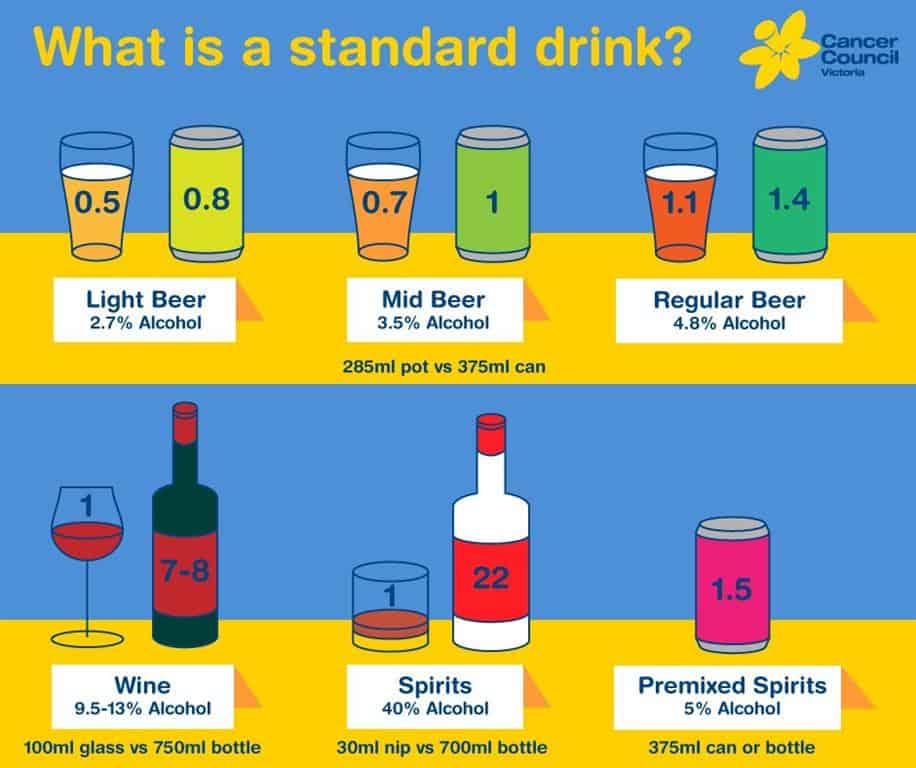 Compelling new data released by an Australian non-profit cancer charity confirm that regular alcohol consumption over a lifetime significantly increases a person’s risk of mouth and throat cancer.
Compelling new data released by an Australian non-profit cancer charity confirm that regular alcohol consumption over a lifetime significantly increases a person’s risk of mouth and throat cancer.
Using data from the Melbourne Collaborative Cohort Study − which has tracked the drinking habits of 41,000 adults since the early 1990s − researchers from Cancer Council Victoria found that average lifetime consumption of four or more standard alcoholic drinks per day more than doubled the risk of mouth and throat cancer, compared with drinking no alcohol at all.
These findings form the basis for the charity’s Drink Less, Live More campaign, which encourages Australians in the state of Victoria to limit their alcohol intake to no more than two standard drinks in a single day. The campaign features a graphic advertisement showing stains left by the base a bottle of red wine spelling out the word ‘cancer’.
Head of Prevention at Cancer Council Victoria, Craig Sinclair, said it was important for people to realise there is a definite link between alcohol and cancer and to correctly assess how much alcohol they are actually consuming.
“The findings of the Cohort study add to the already considerable body of evidence on the link between alcohol and cancer. Long-term alcohol consumption causes an estimated 2,950 new cancer cases each year in Australia, which to put it into context means about the same number of Australians die from alcohol-related cancers as from melanoma,” Mr Sinclair said.
“Not only is alcohol a risk factor for mouth and throat cancer but it’s also linked to other cancers such as oesophagus, bowel (colon and rectum), liver and female breast. In Victoria in 2010, there were 351 cancer deaths that could be linked to alcohol use.”
A separate online poll of over 500 residents’ attitudes towards the health risks of alcohol also released suggested that nearly half of respondents (46%) felt alcohol made no difference or were not sure if it had any effect on a person’s risk of cancer. Only one in eight (13%) had an accurate understanding of the number of standard drinks in a bottle of wine (examples illustrated).
“We are very concerned that people are either not aware of the link or are choosing to ignore it. This concern is compounded when you consider that many Victorians are more often than not, grossly underestimating the amount they are drinking and putting their health at risk without realising it.”
“Our message is clear: If you do choose to drink alcohol of any type, be aware of how much you’re drinking and limit your intake to no more than two standard drinks a day.”
“Any reduction in how much alcohol you drink will help reduce your risk and choosing not to drink at all is the best way to reduce your risk of alcohol related cancers,” said Mr Sinclair.
Publicans lobbied to ban sale of alcohol at sports clubhouses
Letters released under Freedom of Information Act reveal attempt to distract Irish Government from plans to ban alcohol sponsorship of sports events
A trade association representing Dublin’s publicans had lobbied the Government to ban the sale of alcohol at sports clubhouses instead of prohibiting drinks companies from sponsoring sports events.
Letters released to the Irish Examiner under the Freedom of Information Act reveal several appeals made by the Licensed Vintners Association (LVA) to Irish health ministers between June 2013 to February 2015 regarding the Alcohol Bill.
The LVA first made their proposal to the then health minister, James Reilly, as part of its submission on the Government’s Public Health (Alcohol) Bill, which is expected to come before the Oireachtas this year.
“We believe that a ban on alcohol sponsorship of sports events would be completely ineffective and would not achieve any of the objectives in terms of reducing underage access to, and consumption of, alcohol,” wrote LVA CEO Donall O’Keeffe on July 15, 2013.
“It would be a far more tangible step to prohibit the sale of alcohol at all sports clubs if the Government wishes to send a clear message regarding linking alcohol to sport.”
Mr O’Keeffe also remarked that the LVA backed minimum pricing but was “terrified” such a measure would be achieved by raising excise duty.
He said the LVA would be in favour of a “lid-on levy” that targets off-licence trade.
The Royal College of Physicians of Ireland, the Irish Medical Organisation, and the Environmental Health Association Ireland all wrote in favour of a ban on alcohol sponsorship of sports events.
The National Youth Council of Ireland suggested a “social responsibility levy” on drinks companies which would be allocated to sports organisations hit by any sponsorship ban.
“Alcohol is a drug and, as such, should not be perceived as a normal component of sporting activity,” said Frank Murray, chair of the Royal College of Surgeons in Ireland Policy Group on Alcohol.
ASA bans Smirnoff TV ad
Regulator orders Diageo to “filter out” unnecessary reference to alcohol
Diageo plans to appeal the Advertising Standards Authority’s (ASA) decision to ban its latest Smirnoff vodka advert from being broadcast on television.
The ASA said that the “Filter” ad − launched as part of a £15 million campaign for the UK’s best-selling spirit brand last year − implied that the success of a social occasion “depended on the presence of alcohol”.
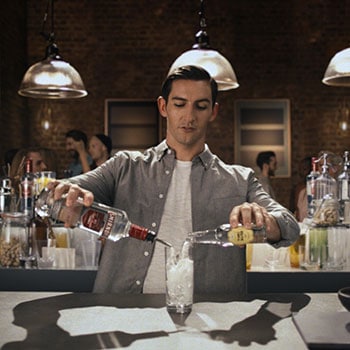 The ASA described the advert (pictured) in its ruling as follows:
The ASA described the advert (pictured) in its ruling as follows:
“A TV ad for Smirnoff vodka depicted people standing in a bar, looking unfriendly and the ad was shot as if the camera were a person walking amongst them and through the bar. A bartender then poured vodka and a mixer into a glass and music started to play. The atmosphere of the bar became brighter and the people in the bar began to smile at each other and towards the camera. On-screen text displays the phrase ‘FILTER THE UNNECESSARY. KEEP THE GOOD STUFF’”.
Diageo argued that the ad showed a move from a “pretentious” to a “relaxed” bar scene following a tilt of the bar itself, rather than the presence of alcohol. It claimed that the tilt acted as a physical division between the frosty atmosphere encountered by the visitor at the beginning and the more welcoming environment depicted by the end of the advert.
But the ASA observed that the nature of the advert changed once the visitor signalled to the barman for an alcoholic drink:
“We considered the ad’s presentation implied that before the visitor asked for an alcoholic drink, the bar was cold and uninviting and that once his drink had been ordered, the bar changed and became livelier and more fun. We considered the contrast between the two implied it was the presence of the alcohol that was the pivotal point in the bar’s transformation. We therefore considered the ad implied that the success of the occasion − the night out at the bar − depended on the presence of alcohol”.
The regulator ordered that the advert was in breach of UK Code of Broadcast Advertising (BCAP) Code rules 1.2 (Social responsibility) and 19.4 (Alcohol), and must not be broadcast on television again in its current form.
Julie Bramham, Smirnoff marketing director, called ASA’s decision ‘deeply disappointing’. But Tom Smith, Head of Policy at Alcohol Concern, expressed disappointment at Smirnoff for breaking advertising rules despite having a wealth of experience and resources at its disposal.
Commenting on the ruling, he wrote: “Questions need to be asked of the Clearcast vetting process that cleared this advert for broadcast.
“Unfortunately, the flaws of the current regulatory system mean that the advert has already been seen by millions. Its removal from broadcast now is too little, too late.
“Smirnoff’s marketing states that it ‘wants to make good times better for the many’. It would be better for all concerned if the brand stuck to the advertising rules in future.”
Wales: Government consults on minimum alcohol price
Government plans to make selling alcohol for less than 50p illegal
The Welsh Government has announced a consultation on its plans to introduce a 50 pence minimum unit price, which will run until December 2015.
The idea, first unveiled last year, has now moved a step closer after ministers published draft legislation for the Public Health (Minimum Price for Alcohol) (Wales) Bill, and are now inviting the public to have their say.
A 50p minimum unit price is worth an estimated £882 million to the Welsh economy in terms of reductions in illness, crime and workplace absence over 20 years. Alcohol misuse in Wales is estimated to cost the Welsh NHS around £109m every year in hospital admissions alone.
The Sheffield Alcohol Policy Model’s findings indicated a 50 pence minimum unit price could reduce Welsh alcohol-related hospital admissions by more than 1,400 and save 53 lives each year. Crime would also be expected to fall by an estimated 3,684 fewer offences a year, and workplace absences would also fall by up to 10,000 days per year.
Wales deputy health minister Vaughan Gething said tackling alcohol misuse was a priority for the Welsh Government. He said that “minimum unit pricing will affect those drinks sold at an unacceptably low price” and was “a particularly well-targeted measure as it will only have a small impact on moderate drinkers and have the biggest impact on high-risk drinkers.”
The likely success of the draft Public Health (Minimum Price for Alcohol) (Wales) Bill will still be reliant on the outcome of the current Scottish MUP battle, still going through the European courts. Scotland first passed legislation to implement a 50 pence MUP in 2012, but a number of industry bodies represented by the Scotch Whisky Association mounted a legal challenge.
The consultation on the draft Public Health (Minimum Price for Alcohol) (Wales) Bill will run until December 11.
‘Successful ageing’ linked to harmful drinking among over 50s
“Middle class phenomenon” occurring among relatively affluent older people
The over 50s who are ‘successful agers’ − healthy, active, sociable, and well-off − are more at risk of harmful drinking than their less successful peers, concludes research published in the online journal BMJ Open.
Harmful drinking is a “middle class phenomenon” which may be a hidden health and social problem in otherwise successful older people, warn the researchers, who call for explicit guidelines on alcohol consumption for this group.
They base their findings on more than 9,000 responses to the two most recent waves (2008-9 and 2010-11) of the English Longitudinal Survey of Ageing (ELSA) − a long term study of a representative sample of those aged 50 and above living independently at home in England.
Survey participants were asked about a range of potentially influential factors: income; educational attainment; self reported health; whether they smoked; diet; physical activity levels; whether they felt lonely or depressed; ethnic background; marital status; caring responsibilities; religious beliefs; employment status; and social engagement (civic participation, networks of friends, cultural activities).
Analysis of the responses showed that the risk of harmful drinking peaked for men in their early 60s and then gradually tailed off, whereas for women risky drinking fell in tandem with age.
These patterns suggest that the current group of over 50s may be carrying on levels of higher consumption developed in their younger years, in later life, say the researchers.
Certain factors were linked to a heightened or lowered risk of harmful drinking.
For women, being younger and having a higher income at baseline increase the probability of becoming a higher risk alcohol drinker over time.
For men, not eating healthily, being younger and having a higher income increase the probability of becoming a higher risk alcohol drinker.
Furthermore, the presence of children living in the household, being lonely, being older and having a lower income are associated with ceasing to be a higher risk alcohol drinker over time.
“We can sketch − at the risk of much simplification − the problem of harmful drinking among people aged 50 or over in England as a middle class phenomenon: people in better health, higher income, with higher educational attainment and socially more active are more likely to drink at harmful levels,” write the researchers.
“Our findings suggest that harmful drinking in later life is more prevalent among people who exhibit a lifestyle associated with affluence and with a ‘successful’ ageing process,” they add.
“Harmful drinking may then be a hidden health and social problem in otherwise successful older people,” they warn, concluding: “Consequently, and based on our results, we recommend the explicit incorporation of alcohol drinking levels and patterns into the successful ageing paradigm.”
MEPs concerned over lack of effective actions on alcohol
First published by Eurocare
A group of concerned Members of European Parliament (MEPs) is alarmed by the lack of an effective and ambitious EU policy on alcohol.
Earlier this year the European Parliament in its Resolution on 29 April 2015 demanded a comprehensive and focussed EU Alcohol Strategy. At the last European Alcohol and Health Forum (EAHF) meeting in May Commissioner Andriukaitis announced that the Commission has no plans to establish a new EU Alcohol Strategy.
Following the announcement public health NGOs resigned from the EAHF, this Forum was established to support the implementation of the previous EU Alcohol Strategy, which ended in 2012. With no new strategy planned, membership of the forum cannot be justified.
A group of concerned MEPs − Glenis Willmott MEP, S&D Co-sponsor of the Resolution on the Alcohol Strategy, Matthias Groote MEP, S&D ENVI Coordinator, Jytte Guteland MEP, Anna Hedh MEP − wrote on 24 July 2015 an open letter to Commission President Jean-Claude Juncker and Commission First Vice-President Frans Timmermans expressing their deep concern. The Commission’s decision goes against the direct demands from Member States and the European Parliament for a new comprehensive strategy to tackle alcohol harm in Europe.
The MEPs wrote: “We object to the European Commission’s decision to continue hosting the European Alcohol and Health Forum now that the public health and civil society stakeholders have left. The Forum would know more properly be re-named the ‘Alcohol Industry Forum’. We have serious reservations as to whether the Forum has been an effective use of public funds and has been abused as a means of persuading the Commission to shelve necessary policy proposals. We call for the Forum to be cancelled or suspended until concrete policy action on alcohol is proposed.”
Similarly the ENVI Committee Coordinators have written to Commissioner for Health and Food Safety, Vytenis Andriukaitis, expressing also their concerns with the lack of will from the European Commission (EC) to propose a new EU Alcohol Strategy.
However, alcohol policy appears to be a victim of the Juncker-led Commission’s general approach to EU policy agenda. Juncker announced that the EC will focus on the issues where it has exclusive competence in terms of legal powers, can show direct added value of European action and are of utter most importance. He is reported to have said: “I want to be serious about being big on big things and small on small things”. But surely given the burden of alcohol on the budgets of the EU countries (an estimated €155bn a year), alcohol policy should be considered a big enough thing.
It remains to be seen what stand will the European Commission take on alcohol policy after the summer vacations.
Problem drinkers ‘trade down’ to cheap cider and vodka
New research reinforces public health argument for minimum pricing
Minimum unit pricing could reduce the social harm caused by excessive consumption by curbing problem drinkers’ access to cheap strong ciders and spirits, a new study carried out in Edinburgh and Glasgow suggests.
Edinburgh Napier University researchers found that when alcohol was less affordable heavy drinkers maintained their consumption levels by “trading down” to cheap but high alcohol content drinks like white cider and low-price vodka.
The study ‘Alcohol pricing and purchasing among heavy drinkers in Edinburgh and Glasgow’ was funded by the Chief Scientist Office and the charity Alcohol Research UK and involved interviews over a period of two to three years with more than 600 NHS patients who had been harmed by their alcohol intake.
Cheap alcohol, in particular vodka and white cider, accounted for most of the units consumed by the study’s participants. Off-sales accounted for 95% of their purchases, and 85% of those purchases were for alcohol priced cheaper than 50p/unit.
White cider, which can be bought at 17p a unit, was a very common fall-back drink for people of restricted financial means. Of 639 patients interviewed, 161 (25%) had drunk white cider in their most recent or ‘typical’ week of drinking. 72 of them drank white cider exclusively.
The researchers anticipate that the impact of MUP would be immediate, particularly for white cider, cheap amber cider and cheap vodka drinkers, with its introduction reducing access to products which are key to maintaining high levels of consumption among the country’s heaviest drinkers. They also argue that the introduction of a minimum price of 50p per unit would remove this option, with the price of a bottle of white cider rising from around £1.28 to approximately £3.75.
Commenting on the findings, Dr James Nicholls, Director of Research at Alcohol Research UK, said: “This study shows clearly the damaging effects very cheap alcohol can have on individuals and society, and the alcohol industry cannot shirk its responsibility in this respect.
“At the cheapest end of the market, producers compete to attract consumers who are often drinking at very dangerous levels. Self-regulation has done little to curb this, and while minimum pricing is not a silver bullet it would establish a limit on the very cheapest products.
“Industry trade bodies need to explain why, in the light of the problems set out in this report, they are still fighting tooth and nail to stop the Scottish Government from introducing its stated pricing policy.”
SHAAP to host Alcohol and Young People conference next month
Date: Thursday 27 August. Venue: Royal College of Physicians and Surgeons of Glasgow
Scottish Health Action on Alcohol Problems (SHAAP) will host a conference on Alcohol and Young People in Glasgow next month.
The event will focus on SHAAP’s findings from its evidence review, which brought together policymakers and experts from the fields of genetics, neuroscience and social psychology to review and discuss new and emerging medical and scientific research about the impact of alcohol on the adolescent brain and implications for policy and practice.
This conference provides the opportunity for policymakers, academics, those who work with young people and young people themselves to discuss SHAAP’s findings and recommendations and:
- Learn from the latest research on alcohol use and young people
- Discover how alcohol affects brain development in adolescence
- Discuss how we can protect young people from the impact of a significant other’s drinking
- Consider how protecting young people from alcohol related harm should be embedded in national and local policy
- Identify how emerging evidence on the impact of alcohol of the adolescent brain can be used to inform health promotion and education.
Information about the conference is available here: http://briefings.holyrood.com/alcohol-and-young-people-27-august-glasgow
For more information please contact Erin Townhill, by email erin@holyrood.com, or phone 0131 272 2119.
Podcast
Our monthly podcast features interviews with experts from across the sector.
Gambling industry harms and parallels with the alcohol world
Will Prochaska –
Coalition to End Gambling Ads

